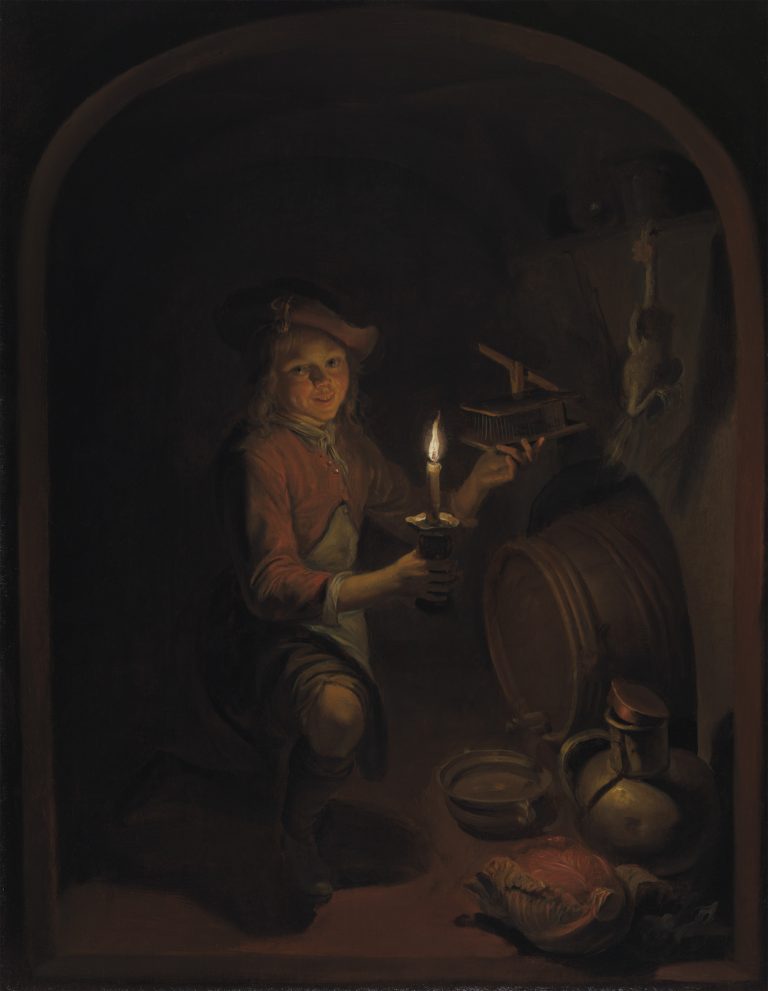In the corner of a dark wine cellar, a boy smiles as he proudly raises a wooden trap to show the viewer the mouse he has just captured. His candle’s flame illuminates his excited face and the objects around him while casting shadows onto the floor and walls. The differences in the delicate rendering of brightly lit elements—the boy’s face, hair, white collar, and the foreground still life motifs—and the freely brushed shadows simulate the effects of flickering candlelight.
The high quality of this small panel, as well as its charming details and distinctive chiaroscuro effects, explains why it has been traditionally attributed to Gerrit Dou (1613–75), Dominicus van Tol’s uncle and teacher. Indeed, the painting has been attributed to Dou, who was known for his virtuoso technique in the rendering of candlelit scenes throughout its recorded history, dating back to 1739, when it appeared in an Amsterdam auction.1 Only in 1990, when Ronni Baer rejected the attribution to Dou, was the painting correctly associated with Dominicus van Tol.2 In particular, this work closely resembles two other pictures by Van Tol: one with a similar subject, Children with a Mousetrap in the Rijksmuseum (fig 1) and Children at a Window Blowing Bubbles in The Leiden Collection (fig 2).3 Not only are the facial features and clothing of the boys in these three pictures similar, but also the manner in which Van Tol modeled their forms.
An anonymous biographer from the second half of the eighteenth century noted that Van Tol owed much to Dou’s artistry: “In our view, he came most close to his uncle’s manner and adhered to it.” 4 Van Tol often adapted Dou’s motifs and subjects in his own works—sometimes, as in this instance, coming very close to the style of his master. Here, for example, he placed his scene within an illusionistically painted stone window, a pictorial device Dou frequently used.5 Although Van Tol’s painterly technique is generally somewhat broader than that of Dou, in this painting he adopted a refined style to emulate his master. Van Tol’s subject also relates to a number of Dou’s works, including Wine Cellar (fig 3) of ca. 1660. Dou’s painting, depicting lovers surreptitiously meeting in a dimly-lit cellar illuminated by a lantern and candle, includes still-life motifs similar to those in Boy with a Mousetrap by Candlelight, including a mousetrap, a wooden barrel, a head of cabbage and a milk jug.6 Also important for Van Tol’s pictorial concept are two paintings by Dou that depict a young boy, with a similarly round face and curly blond hair, holding a mousetrap: Mousetrap, ca. 1650,7 and another work known today only from a mezzotint by Nicolaas Verkolje (1673–1746).8 Van Tol’s picture is not dated, yet dendrochronological analysis of the panel and the above mentioned similarity with Dou’s Wine Cellar point to a plausible date around 1664–65.9
Depictions of a boy with a mousetrap enjoyed great popularity among Dutch painters of the late seventeenth and early eighteenth centuries, including Quiringh Gerritsz. van Brekelenkam (1622/29–69/79), Eglon van der Neer (1635/36–1703), Adriaen van der Werff (1659–1722), and Louis de Moni (1698–1771).10 At first glance the subject appears to be a portrayal of everyday life, but the motif of the mousetrap could also convey an amorous message. For instance, in Dou’s Wine Cellar, the flirtatious interaction of the young couple in a dark cellar combined with the presence of wine may indicate that the mousetrap alludes to love’s sweet slavery or the entrapment of love, a connotation found in contemporary emblem books and proverbs.11 One of Jacob Cat’s emblems in Sinne- en minnebeelden (1627) illustrates a mouse caught in a trap and warns that those who are greedy in love fall prey to the object of their desire. Daniel Heinsius, in an emblem in his Emblemata Amatoria (Leiden, ca. 1621), also compares a man who cannot live without love to a mouse, with no viable choice between a trap and a cat (fig 4).12
Although love’s seduction is not explicitly depicted in Van Tol’s painting, the intimate atmosphere of the dark cellar and the presence of the wine barrel and the fowl, both of which had strong sexual associations, suggest that the mousetrap alludes to love’s captivity.13 Even the smiling boy displaying the mousetrap may serve to communicate the dangers of love to innocent youths.
Van Tol’s stylistic and iconographic dependence on Dou’s work indicates that he was intimately familiar with the master’s paintings when he created this scene. Since Van Tol became a member of the Leiden Guild of Saint Luke in 1664 at the relatively advanced age of 29, it is presumed that he had previously worked as an assistant in the studio of his uncle and would have remained close to him before he left Leiden for Utrecht in 1669.14 This close connection to Dou might explain why the picture has certain qualities strongly reminiscent of the master’s work, as well as its subsequent long-standing attribution to him.15
Although we have no certain knowledge about Dou’s studio practice and his collaboration with his pupils, a group of paintings by different hands reflecting the master’s style suggest that he had a number of apprentices and students in his studio.16 As is the case with the current picture, their pictures were sometimes sold later as authentic works by the master, as noted by the eighteenth-century anonymous biographer mentioned above. When writing about Jan Adriaensz. van Staveren (1614–69), another pupil of Dou, he notes that “art dealers have long been buying up the most and best work [by Van Staveren], together with other paintings by different pupils of Gerard Dou, and selling these as paintings by Dou in foreign countries.”17 The attribution of the Leiden Collection picture to Dou was repeatedly authorized by art dealers like Willem Lormier, the most prominent dealer of the eighteenth century. After Lormier’s death in 1763, the painting was sold at auction and fetched 1,000 guilders—five times more than what he had originally paid only two decades earlier.18
